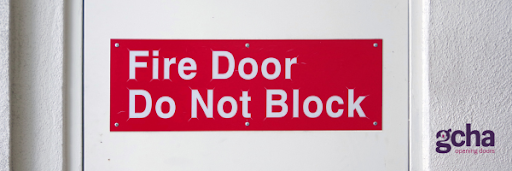Fire Doors In Your Home

Fire Doors: Your safety matters
Fire doors play a vital role in keeping you safe. Here’s how:
What do fire doors do?
Fire doors create a barrier from fire and toxic cold smoke and prevent it from travelling around a building. Keeping the damage to a small area, allowing for evacuation, stay put and safe access for the emergency services
What makes a fire door work?
All these components play a CRITICAL role in fire performance 1 small change = 1 BIG impact on fire performance. Always check the fire door certificate for compatable specification
Where will I see fire doors in my building?
In a block of flats you will find fire and smoke control doors on the stairwells, the corridors and on the front doors. You will also see the protecting areas where there is a rist of combustion, such as bin storage, or mains electricity service cupboard. Sometimes you will find fire doors inside flats but this depends on the specific design and layout of the individual flat.
How do I know it’s a fire door
Fire doors in common areas of the building (corridors, stairwells and service rooms) will have blue signage on the door. Flat front and those inside individual flats do not require signage. BUT! A fire front door only works if it’s installed correctly with the compatable components like ironmongery, seals and frame.
Who’s responsible for inspecting and maintaining fire doors in my building?
GCHA has a legal responsibility for the fire doors in the common areas of the building. Fire notices are displayed in common areas. This provides residents with information on what to do in the event of a fire.
What about door closures?
All fire doors in common areas of the building AND flat front doors (corridors and stairwells) must has appropriate fire rated door closures fitted. These closers MUST be adjusted correctly to ensure the opening and closing forces are correct and that the door can be operated easily. Regulare inspection and maintenance is required to ensure these components work correctly… OTHERWISE! You risk door closers being damaged or disengaged, so they won’t work when needed. Door closers on flat front doors should only be fitted to the interior side of the door to prevent vandalism and to allow for the door to be correctly adjusted when the closer is fitted.
Do all fire doors have cold smoke seals?
Don’t confuse plain intumescent seals with cold smoke seals. The majority of fire doors, especially those on flat front doors, corridors and on stairwells will have cold smoke seals. You can see these seals because they are either separate from or combined with the intumescent seal, they look like a brush or a plastic tin. They are located in either door edge or the frame and they should COMPLETELY fill the perimiter gap between the door and the frame when the door is closed.
Who do I report issues to?
In the first instance, contact Quarterly inspections will be carried out to all communal fire doors Annual inspections will be carried out to all flat front entrance fire doors
Who do I report issues to?
In the first instance, contact:
Email: general@gcha.org.uk
Tele: 01474 369 830
Quarterly inspections will be carried out to all communal fire doors
Annual inspections will be carried out to all flat front entrance fire doors